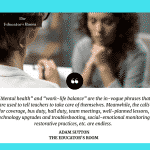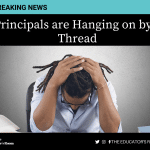Have you signed up for The Educator’s Room Daily Newsletter? Click here and support independent journalism!
I posted this question on several Facebook principal groups. I asked, “Has anyone left the admin position and switched careers? Why did you leave the profession?” I heard back a resounding “Yes!” Approximately 150 persons replied with reasons the job was no longer worth it. School administrators are walking out the door and not looking back. We continue to hear about a mass exodus and shortage of teachers, but principals will be missed, too.
Many pour more than 100% of themselves into the principal position. Eventually, their glass becomes half-full or empty. Looking in from the outside doesn’t give a clearer view of everything a principal represents in a school building. Even some teachers and staff members do not understand how mentally and physically tough it is to be a school administrator. We hear so much about the difficulties of being a teacher. We see posts, videos, or reels complaining about their school principal or administrators on social media.
As a former principal, I can tell you that teachers have a love-and-hate relationship with administrators. They are at fault for all the negative things happening in a school. Someone must take the blame. Tag, you’re it, Principal! How often have you heard a teacher say, “My principal forgot what it takes to be a classroom teacher?” The complaints come from not only staff but also parents and community members. At some point, an administrator realizes it’s not a win-win situation. Some even feel it is a total lose-lose situation, and they take the “L” and pack up to leave.
When Principals Leave, Schools Lose Consistency
When seasoned principals leave, they are missed for a significant reason, consistency. Schools, students, and staff members need consistency. An essential tool in effective schools is consistency. Schools are often the hub of a community, and often the leader is perceived as the problem-solver, communicator, collaborator, or go-to person in times of need. We know that teacher turnover hurts schools, but we don’t often talk about the impact of principal turnover. If a school continually has a turnover of principals, it will not be successful. If a school has a high teacher turnover rate, it will not be successful.
Furthermore, school success takes years to put a stable staff in place. Schools need sage and wise educators to not only teach the children but to help train and support new educators and staff members. Consistency helps to pass the torch to the next generation of principals.
It takes time to rebuild the culture of a school when a principal leaves. If there is a revolving door of principals, then a school may not ever gain its footing. I know of several schools in an urban district that received an interim principal every six months to a year. Imagine if a school receives an interim or new principal every six months to two years. The students and staff members are constantly starting over. Each interim principal has different ideas on how the school should run. There is no time to build essential relationships or to create a vision or mission. The principal walks in August and is gone by the end of January. It is like a rudderless ship.
Why Principals Are Leaving
Why are principals leaving the profession? Based on the responses received, I saw a pattern of five issues. They are the pandemic, lack of support, respect for principals, work/life balance, politics, lack of safety, and mental and physical health. Those who responded had five to 20 years of administrative experience. That’s a large amount of experience, knowledge, and wisdom walking out of the door. How do you replace these people when new principals stay an average of three years? Replacing the number of persons leaving and watching the knowledge and wisdom walkout can be challenging.
Here are a few examples of responses from the Facebook groups.
- “I experienced a hate crime and sexual harassment at work. Suing the district caused me to be blackballed in every neighboring district. I was pushed out.”
- “After 22 years, my mental health became first and foremost.”
- “I retired in 2021. I am no longer a security guard when people misbehave. No more taking work home. No more 12-14 hour days.”
- “I loved my school and district but struggled to balance the demands of being a principal during COVID.”
- “I left because of a lack of district support. I can do hard for kids and families, but not if the district does not support me. It wore me down, and my life in all aspects struggled”
- “I quit because I got whiplash. I couldn’t track whether we were heroes or villains or somewhere in the middle.”
Teachers and Principals Both Want Support
It’s challenging to replace influential leaders. Teachers are the pipeline and future principals. If there is a teacher shortage, the channel is drying up. Fewer teachers equal fewer school administrators in the coming years. How will the numbers be replenished? Can people be convinced to stay in the profession?
Many principals and school administrators want more support from their districts. Support looks different to different people. It may range from feeling like you have backup when dealing with a difficult situation or a safety issue. Some support may be the ability to pick up the phone and communicate and be heard by district leaders. If you ask ten people to define what support means, you may get ten different answers.
A topic that comes up often is the wellness of administrators. Many leave because the job is detrimental to one’s physical and mental health. The work/life balance is almost non-existent, and no one can sustain the day-to-day grind. Districts must recognize that grind will continue to push people away from the profession. It’s time to lessen the expectation that a 12-14 hour day is normal.
It is also time to recognize that educator wellness is a priority. While self-care is a popular term, healthy working environments must not be the onus of educators. School districts try innovative ways to prioritize teachers’ and administrators’ health and wellness. Of course, it will take resources and funding; however, the most significant resource is the people on the jobs. Be willing to spend money on counseling, wellness programs, life coaches, and professional development services. If investments are not made, principals will continue to leave and be missed.
Editor’s Note: If you enjoyed this article, please become a Patreon supporter by clicking here.






